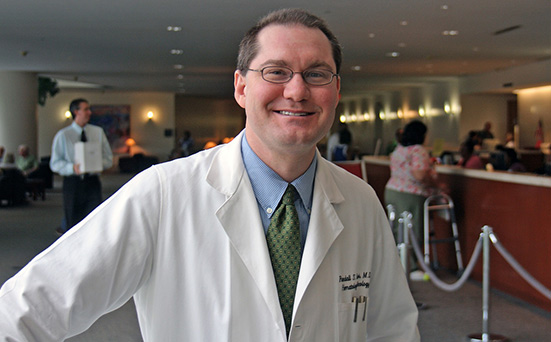 Randall Davis, Ph.DPhysician-scientists spend hours in the lab seeking answers to the questions created by deadly diseases, but their days do not end or begin at the lab door. A significant amount of time is spent at their desks finding ways to secure the funding necessary to continue potentially life-saving research.
Randall Davis, Ph.DPhysician-scientists spend hours in the lab seeking answers to the questions created by deadly diseases, but their days do not end or begin at the lab door. A significant amount of time is spent at their desks finding ways to secure the funding necessary to continue potentially life-saving research. The office of Dr. Randall Davis illustrates just what that work means. In his office at UAB’s Shelby Biomedical Research Building, there are stacks upon stacks of paper on his desk and on the floor, an organized chaos reflecting life as a physician and scientific investigator.
“Medical research now has seen significant cutbacks in government funding, which is not keeping up with inflation,” Davis said. “That has really made this a difficult process. You struggle from one grant to the next.”
But the same people who may someday benefit from the work of physician-scientists like Davis can also play a part in the research effort. Contributions from grateful patients and the people who love them can accelerate the pace of scientific discovery.
In August 2013, Davis participated in a training session for UAB physicians on how to respond to patients who express a wish to help them through philanthropy. Since then, gifts from patients have provided an additional 15 percent of his lab’s annual budget. By using those philanthropic funds to increase funding for pilot studies, Davis successfully competed for a $1.6 million grant from the National Institutes of Health to expand his work in cancer immunobiology over the next four years.
Davis’ story illustrates one of the most common – and powerful – ways in which grateful patient gifts make a difference.
All biomedical discoveries have one thing in common: They begin with an idea. However, applications for federal research grants can only be completed after researchers have gathered conclusive data from extensive laboratory studies. Philanthropic support enables ideas to be developed and tested in early studies that can lead to federal funding. Seed funding and initial investments lay the foundation for UAB to develop game-changing medical breakthroughs.
Karen Cunningham of Birmingham said there was no doubt in her mind that she had to help. “Since I do have a rare type of leukemia, I knew that I wanted to try to help find a cure for this, even if it doesn’t help me,” Cunningham said. “It can help someone in the future. I’ve been very pleased with Dr. Davis and how much he cares.”
Davis and his team share updates and progress with patients and donors through a bi-annual newsletter, providing information about published papers, experimental successes, and funding sources.
“It took me a while to really think about what it meant to get involved in this kind of fundraising,” Davis said. “What I ultimately realized was that it’s really not for me. It’s a program that is dedicated to the betterment of understanding how leukemia and lymphoma develop and what new therapies we can generate.”
Davis said having a connection with his patients is what makes the work in his lab so rewarding. “A patient recently came to tour the laboratory, and we actually had cells from that patient that we had drawn in the clinic several days before,” he said. “The patient had the opportunity to look at his own cells under the microscope. To see this patient, care for the patient, to have him entrust us with this material, and then to bring him in and show him what I’m doing with the 75 percent of my time when I’m not in clinic – that was a very touching experience for me, to see it basically come full circle.”
For more information about supporting cancer research at UAB, contact Chris Thomason, Senior Director of Development, at (205) 934-0930 or cthomason@uab.edu.